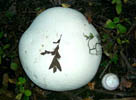(pl. Cryptogamic crusts)
Terms discussed: biological crust (pl. biological crusts), cryptobiotic
The reason that our American deserts don't look like the Sahara is because ours have cryptogamic crusts. These crusts, a tightly bound mesh of various cyanobacteria, lichens, mosses, and fungi, hold the soil down, prevent soil erosion, and provide a hospitable environment for germinating plants. They were probably the first land-based communities of life. In untouched deserts like those in Arizona, New Mexico, Colorado, and Wyoming, over 70% of the ground cover may be cryptogamic crusts.
Unfortunately, the are very vulnerable to crushing (as when you walk on them, or drive over them in an SUV), and it is very difficult for them to recover from this. Soil, freed from the constraints of a footstep's worth of crust, drifts over the neighboring crust and kills it (the crusts are photosynthetic, and require sunlight to survive), and the process of making our Western openlands look more like the Sahara continues. This vulnerability to crushing is hardly surprising, as these communities evolved millions of years before there were any organisms with feet.
Back to top
To learn more about cryptogamic crusts, visit the following websites:
Capitol Reef - Cryptobiotic Soil has a good introduction to cryptogamic crusts
Biological Soil Crusts Web Site has more information, and more links
Kingdom of the Crusts is similar
Back to top











